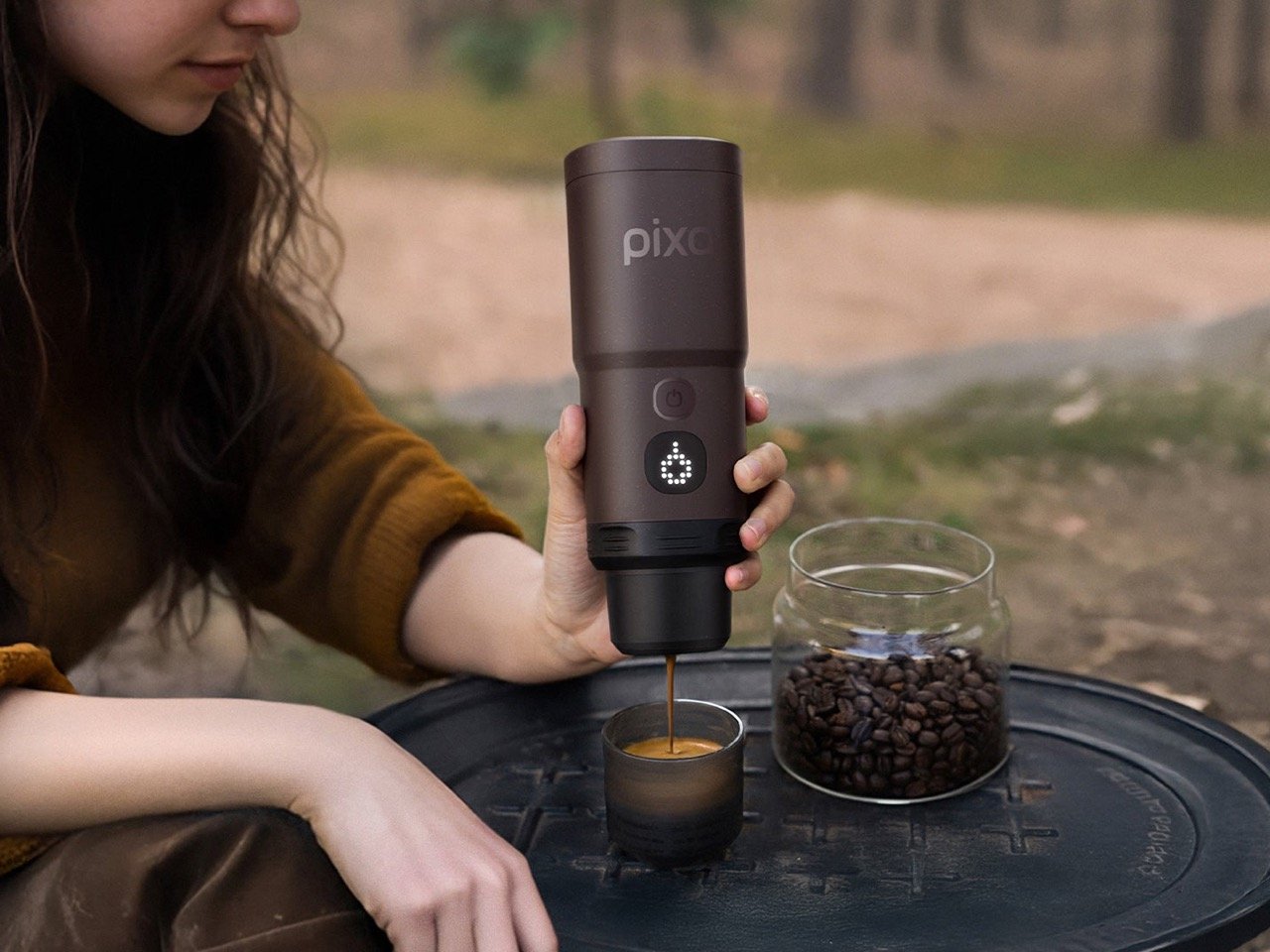The quest for truly good coffee on the go has been a journey littered with compromises, hacks, and a fair share of disappointment. We’ve seen travel-sized pour-overs, dubious instant coffee packets, and even coffee bags (like tea, but worse). For a decade now, Hong Kong-based Wacaco has been the plucky protagonist in this caffeinated saga, building increasingly sophisticated manual espresso makers that have earned cult status among coffee nerds who refuse to sacrifice quality for convenience.
Their latest creation, the Pixapresso, marks a watershed moment for the company. After years of championing the “no electricity, no battery” approach with their Minipresso, Nanopresso, and Picopresso lineup, Wacaco has embraced the electric revolution. The result is their most ambitious and capable portable espresso machine yet, one that combines the portability of their earlier offerings with the consistency and ease of use that only automation can provide.
Designer: Wacaco
The Pixapresso stands 181mm tall, weighs 755 grams, and houses a 3000mAh battery that powers both a 20-bar pump and a heating system. That’s legitimate espresso pressure, not the 9-bar approximation many portables offer. The water reservoir holds 120ml, enough for multiple single shots or a couple of doubles, and the adjustable basket accommodates between 8 and 16 grams of coffee. For context, that’s the same dose range you’d find in commercial espresso machines, giving you flexibility between lighter, fruitier shots and deeper, more intense extractions.
The circular ‘Glyph Matrix‘ (sorry Nothing, Wacaco did it better) provides real-time feedback on temperature (with presets at 88°C, 92°C, and 96°C), brewing status, and battery life. That temperature range is particularly impressive, allowing you to dial in extraction parameters for different roast profiles. Lighter roasts benefit from higher temperatures, while darker roasts extract better at the lower end. This level of control was previously unheard of in the portable espresso category, where “hot enough” was typically the only temperature setting available.
Hugo Cailleton, Wacaco’s founder, started this journey back in 2013 with a simple frustration: terrible hotel coffee during business trips. As an industrial designer with a master’s degree, he built over ten prototypes of what would become the Minipresso before launching the company with co-founder Jessie Wang. The name itself is a portmanteau of their surnames plus “cooperation,” reflecting the cross-cultural collaboration at the heart of the brand. This origin story explains Wacaco’s obsessive attention to design details and user experience, traits that remain evident in the Pixapresso despite its technological evolution.
The shift to electric operation introduces meaningful advantages. Pre-infusion, that crucial step where water saturates the coffee grounds before full pressure is applied, happens automatically. The heating element brings water to brewing temperature in just three minutes, faster than most people can grind their beans and prep the machine. Battery life delivers 3-5 shots per charge depending on dose size and temperature settings, sufficient for a day’s caffeine needs for most users. USB-C charging means you can top up from a power bank, car charger, or any modern charging brick.
Wacaco smartly includes both pressurized and non-pressurized baskets with the Pixapresso, acknowledging the spectrum of users they serve. Beginners and convenience-seekers can use the pressurized basket with pre-ground coffee and still achieve respectable results with minimal fuss. Meanwhile, enthusiasts can pair the standard basket with a quality grinder to unlock the full potential of specialty beans. This dual approach prevents the Pixapresso from becoming either too intimidating for casual users or too limiting for coffee geeks.
The burgundy matte finish and semi-cylindrical form factor maintain Wacaco’s design language while adding subtle sophistication. The ribbed lower section serves as both grip enhancement and visual separator between the brewing chamber and cup. Ergonomically, the Pixapresso feels balanced in hand, with the center of gravity low enough to prevent tipping during operation.
Compared to its manual siblings, the Pixapresso demands significantly less physical effort. No more pumping action means no more forearm workouts just to get your caffeine fix. For travelers already dealing with luggage, transit stress, and jet lag, eliminating this small but annoying task makes a substantial difference in the overall experience. The trade-off is the added weight, about 400 grams heavier than the Picopresso, though still lighter than carrying a bag of beans and a manual grinder.
At $159, the Pixapresso occupies an interesting price point. It costs substantially more than Wacaco’s manual machines but significantly less than entry-level home espresso setups. For someone who travels frequently or works remotely from various locations, the math works out favorably compared to daily cafe visits. The ability to use your preferred beans rather than whatever the hotel or Airbnb provides adds further value that’s harder to quantify but immediately apparent in the cup.
The Pixapresso represents Wacaco’s evolution from outdoor gear niche player to lifestyle brand with broader appeal. By embracing electric operation, they’re tacitly acknowledging that their audience now includes urban professionals, digital nomads, and office workers alongside the camping enthusiasts who embraced their earlier products. This expansion mirrors the changing nature of work itself, as remote and flexible arrangements blur the lines between home, office, and “third places” where coffee usually goes to die. With the Pixapresso, Wacaco ensures that good coffee is just about as accessible as WiFi.
The post Wacaco built the World’s Smallest Espresso Maker… and now they’ve turned it Electric first appeared on Yanko Design.

